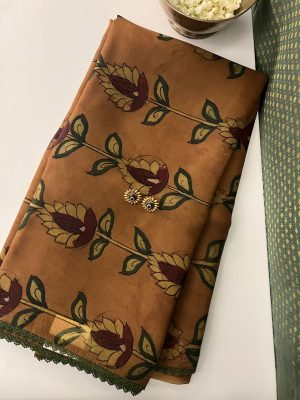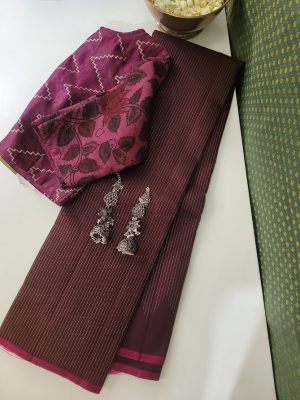Teal Kanchipuram silk fabric with geometric zari design
Note : Pricing by the metre


₹3,970.44
Availability: 3 in stock
Availability: 3 in stock
Teal Kanchipuram silk fabric with geometric zari design
Note : Pricing by the metre
Silk is made from the cocoon of silk worms. India has a rich heritage of silk weaving. Apart from Mulberry silk, India is known for producing tussar, muga and ahimsa silks. Some of these are wild and some of these are farmed commercially. Each of these silks has its own property when it comes to sheen, shine and wear. Being a natural fabric, silk does shed, wear and tear with age. However, caring for them ensures they have a long life. Silk Care & Wash # We recommend air drying silks after every use. Silks do not require washing after every wear unless soiled. # We recommend giving our sarees for dry cleaning for the first few washes. # Silk sarees can be washed at home using a gentle detergent or soap nuts. Avoid soaking & scrubbing these fabrics. Any stains should be dry cleaned. # Avoid tumble dry and instead line dry away from direct sunlight. # Silk sarees should be regularly worn to avoid fraying. If kept in humid or dry spaces for long without wear, silks are likely to detoriate. So wear your sarees well. # If you are unable to wear them regularly, remove them and change folds from time to time. We do not recommend hanging them. If stacked, ensure there isn’t too much weight on the sarees. # Avoid using naphthalene balls or other chemicals while storing silks. Heavy silks may be stores in muslin bags. # If you can, roll them on wooden rods to store them wrinkle free. However, gentle folding works well too.



₹3,970.44
Availability: 3 in stock
Availability: 3 in stock

Teal Kanchipuram silk fabric with geometric zari design
Note : Pricing by the metre
Silk is made from the cocoon of silk worms. India has a rich heritage of silk weaving. Apart from Mulberry silk, India is known for producing tussar, muga and ahimsa silks. Some of these are wild and some of these are farmed commercially. Each of these silks has its own property when it comes to sheen, shine and wear. Being a natural fabric, silk does shed, wear and tear with age. However, caring for them ensures they have a long life. Silk Care & Wash # We recommend air drying silks after every use. Silks do not require washing after every wear unless soiled. # We recommend giving our sarees for dry cleaning for the first few washes. # Silk sarees can be washed at home using a gentle detergent or soap nuts. Avoid soaking & scrubbing these fabrics. Any stains should be dry cleaned. # Avoid tumble dry and instead line dry away from direct sunlight. # Silk sarees should be regularly worn to avoid fraying. If kept in humid or dry spaces for long without wear, silks are likely to detoriate. So wear your sarees well. # If you are unable to wear them regularly, remove them and change folds from time to time. We do not recommend hanging them. If stacked, ensure there isn’t too much weight on the sarees. # Avoid using naphthalene balls or other chemicals while storing silks. Heavy silks may be stores in muslin bags. # If you can, roll them on wooden rods to store them wrinkle free. However, gentle folding works well too.


